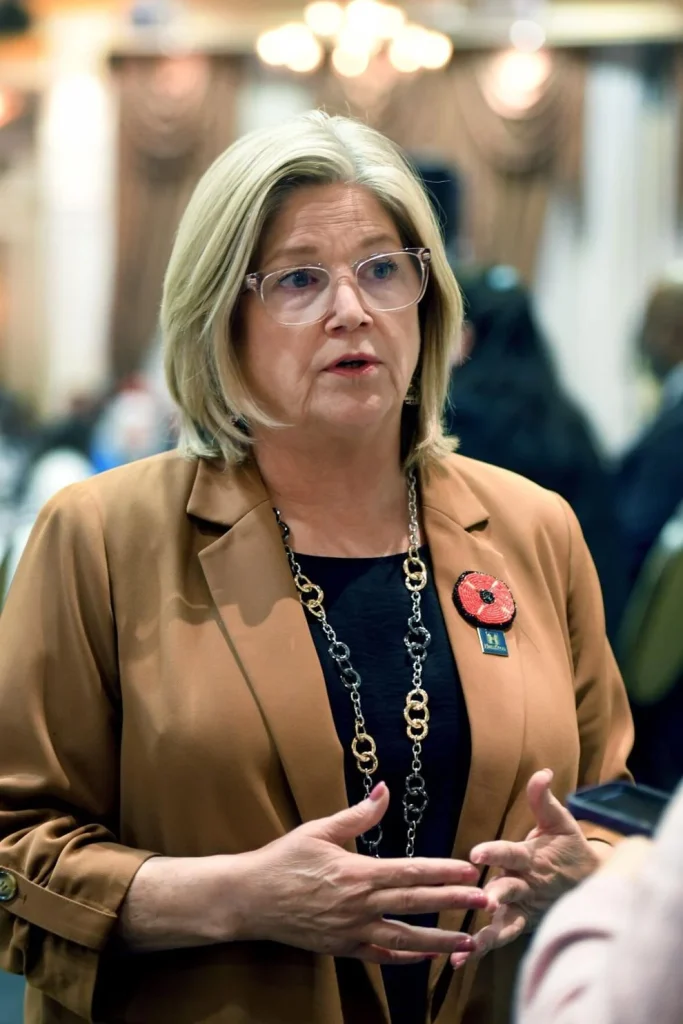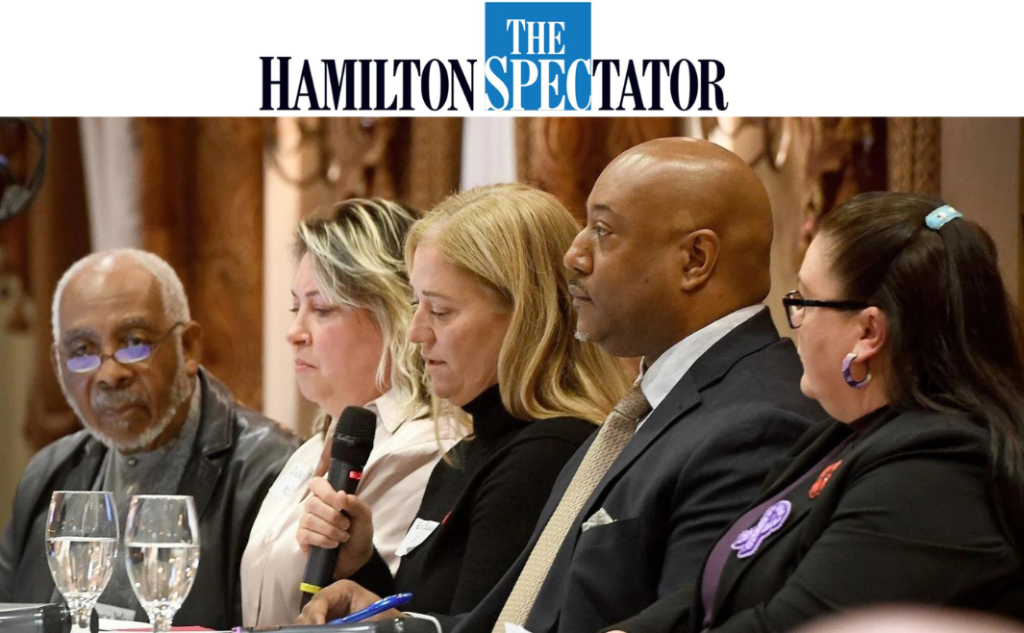On November 10, 2025, our Senior Director of Children, Youth and Family Services, Denise Scott, proudly represented our organization as an expert panelist at the Mayoral Community Safety Summit. She contributed valuable insights on addressing youth violence and strengthening supports for young people in our community.
It was inspiring to see so many community leaders, city staff, police representatives, business owners, elected officials, and engaged residents come together with a shared commitment to creating a safer, more inclusive Hamilton for everyone. Read more in the Hamilton Spectator article below.
Youth crime, shootings, intimate partner violence and hate focus of community safety summit.
(pictured above) Gary Warner was the moderator for a community partners panel at a community safety summit at Liuna Station Monday hosted by Mayor Andrea Horwath. From left, Warner, Denise Scott from Wesley’s Child Youth and Family Services, Erin Buckle from the John Howard Society of Hamilton Burlington, Lyndon George, executive director of Hamilton Anti-Racism Centre, and Danielle Ridge, executive director of the Native Women’s Centre. Cathie Coward/The Hamilton Spectator
Nov. 11, 2025
4 min read

Shootings, violent youth crime, intimate partner violence and the rise in hate in Hamilton were the focus of Mayor Andrea Horwath’s community safety summit.
The summit, at Liuna Station on Monday, heard from community and social service agencies about public safety concerns, with the goal of opening dialogue and looking for solutions.
“Safety is a citywide concern,” Horwath said, adding that shootings and hate incidents leave people feeling unsettled, afraid and worried.
“They are not isolated incidents,” she said. “They affect all of us and they require all of us to respond together.”
Policing is critical, but lasting safety requires more than enforcement alone, Horwath told the crowd.
“Safety begins before a crisis. It begins in strong relationships, in belonging, in opportunity, in dignity,” she said. “It begins when people feel included, supported, seen and connected to their neighbours and community.”
Horwath told The Spectator she hoped the summit provided a space to reduce barriers and be able to have conversations about ways to do things better. Here are a few of the key takeaways:
Shootings
Last year saw a record-high 60 shootings in Hamilton. There have been 31 shootings this year — but despite the overall reduction, there continue to be brazen daytime shootings in public places.
Two innocent bystanders have been killed in shootings this year, Hamilton police Chief Frank Bergen said. Both Belinda Sarkodie and Harsimrat Randhawa were killed at bus stops by the “reckless abandonment of those in gangs.”
These incidents affect the perception of safety, he said, even if violent crime is trending down.
All non-fatal shootings in Hamilton are investigated by the shooting response team (SRT). There have been 13 convictions this year for cases investigated by SRT, with the highest sentence of nine years, said Det. Sgt. Michelle Wiley, of the major drugs and gangs unit.
Youth crime
There were 959 youths involved in some kind of criminal activity last year, said Staff Sgt. Candace Culp, representing a slight decrease from 2023, but an increase over the five-year average.
When possible, police work with the youth and social service agencies to divert cases away from the justice system. But in cases of more serious offences, where a youth fails to complete a diversion program, or they are repeat offenders, young people — aged 12 and 17 — are charged under the Youth Criminal Justice Act.
Last year, nearly 64 per cent of youths were dealt with outside the justice system and 347 youths were charged. The most common offences include low level assault, assault with a weapon and robbery.
Altercations between schools have been around for decades, Culp said, but the difference now is youths use social media to invite more kids to participate and they are bringing weapons — most often bear spray.
Youth co-ordinator Sgt. Jason Tadeson oversees the youth engagement team that consists of three patrol officers with youth backgrounds who work all over the city. Their work includes the strategic targeted offender program (STOP), which tracks high-risk youth offenders, including those out on bail.
Denise Scott, senior director of children, youth and family services at Wesley, said that while there was no “one-size-fits-all” path to young people getting in trouble, the most common issues they see are around a lack of “protective factors.” This includes having access to caring adults and inclusive recreation, along with access to counselling or supports.
She highlighted several programs that help support young people, including the community outreach response for youth (COR) program led by Wesley and partnered with the John Howard Society of Hamilton. It involves community outreach to people 12 to 25 at risk of or involved in violence or high-risk behaviour.
Erin Buckle, manager of programs and service and the John Howard Society of Hamilton, said there are great resources in Hamilton, but also areas they can do better.
She pointed to the “significant gap” in young people being able to access stable, quality employment. In families with financial instability, this can increase a youth’s risk to being involved in crime.
Funding is also a key issue, she said. There are a lot of youth-centred programs in Hamilton but few are focused on early intervention and prevention.
One of the biggest gaps is transitional age support, Buckle said, adding there are few programs that offer services to children under 12 (when the YCJA begins) and also difficulty transitioning youth once they become adults and age out of youth services.

Cathie Coward/The Hamilton Spectator
Hate crime
Hamilton has seen a rise in reported hate incidents in recent years, with the Black community the most commonly targeted for race and the Jewish community most commonly targeted for religion.
Last year, there were 297 incidents reported, of which 106 were classified as hate crimes, said Staff Sgt. Ryan Hashimoto, of the hate crime unit.
The most common hate-motivated crime police see is graffiti with 50 reported cases last year. Police also track hate incidents that do not meet the definition of a crime.
Police recognize that many hate incidents go unreported.
About 20 per cent of hate incidents were reported online last year, and police are hopeful the online tool will make it easier for more people to report.
As of last year, there is also a hate crime case review team that includes 14 community members reviewing 124 cases, said Det. Const. Lyndsay Scott.Hate crime
Hamilton has seen a rise in reported hate incidents in recent years, with the Black community the most commonly targeted for race and the Jewish community most commonly targeted for religion.
Last year, there were 297 incidents reported, of which 106 were classified as hate crimes, said Staff Sgt. Ryan Hashimoto, of the hate crime unit.
The most common hate-motivated crime police see is graffiti with 50 reported cases last year. Police also track hate incidents that do not meet the definition of a crime.
Police recognize that many hate incidents go unreported.
About 20 per cent of hate incidents were reported online last year, and police are hopeful the online tool will make it easier for more people to report.
As of last year, there is also a hate crime case review team that includes 14 community members reviewing 124 cases, said Det. Const. Lyndsay Scott.
“We have to understand these numbers are people,” said Lyndon George, executive director of the Hamilton Anti-Racism Resource Centre (HARRC), which also collects data on hate incidents. Trauma stays with people affected whether or not charges are laid, or whether graffiti is removed.
He advocated for a “public health approach” to addressing hate, likening it to public health campaigns against drinking and driving or smoking.
Intimate partner violence
Hamilton police are asking for funding for an intimate partner violence unit.
Right now, the service has two officers who review cases to make ensure there are thorough investigations, victims are supported and charges are properly laid. But a unit would allow dedicated officers to investigate domestic cases.
There were 6,555 occurrences reported last year, including 1,172 people charged and 3,433 charges laid. The offences include everything from assault, to forcible confinement, to murder, including the homicide of Shalini Singh.
Intimate partner violence was declared an epidemic in Hamilton in 2023.
Danielle Ridge, executive director of the Native Women’s Centre, highlighted significant barriers, including 6,700 requests for shelter being turned down over lack of space and months’ long wait-lists for sexual assault and domestic violence counselling programs.
Indigenous women are at increased risk and represent 21 per cent of gender-related homicides in Canada. Last year, there were 62 femicides across 37 cities in Ontario.
Ridge said more needs to be done to offer “wraparound services” to help survivors leave abusive situations. Services need to be trauma-informed, client-centred and cultural specific, she said.
Ridge added data collection is important for funding applications and to understand where services need to change and grow.

Nicole O’Reilly is a reporter with the Hamilton Spectator specializing in covering police, crime and the justice system. Reach her at noreilly@thespec.com.



